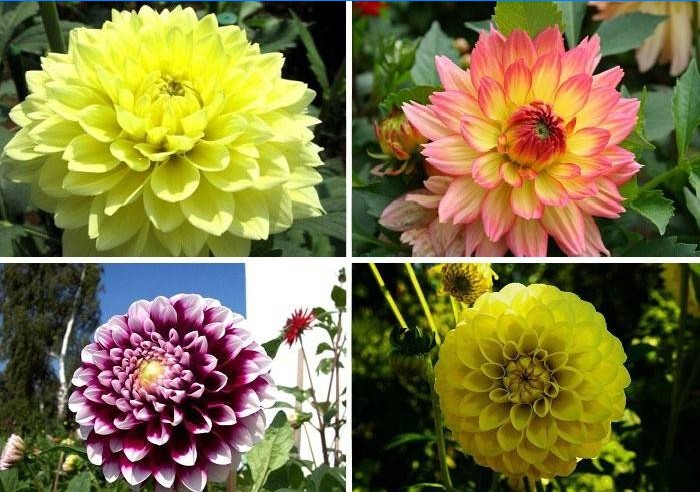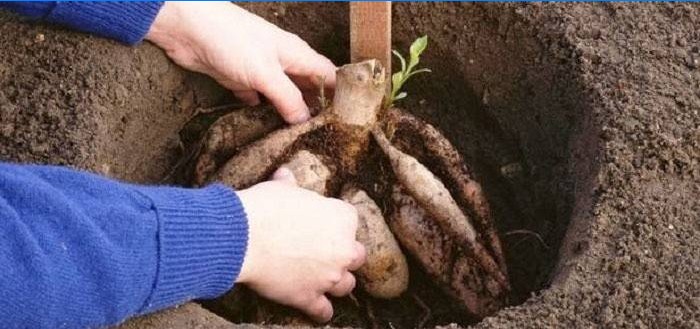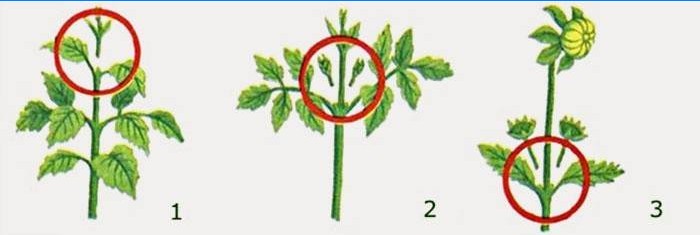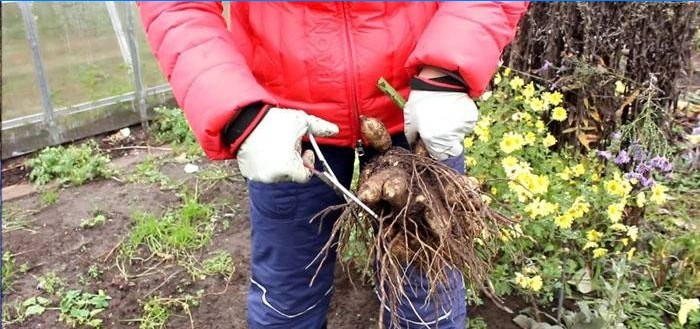The content of the article
- Features of growing dahlias of different varieties
- Rules for planting dahlias at home
- Location
- Soil preparation and planting pit
- The best time to land
- Dahlia root dividing in spring
- Planting dahlias in the open ground
- Dahlia Care
- Digging and storing a dahlia in winter
- Video tips for growing and caring for dahlias
These plants are in great demand among gardeners. And this is understandable. Dahlias are a beautiful and amazing flower. No other garden plant can not meet such a huge range of colors, various forms, like these fabulous flowers. Dahlias with their dense and long flowering will decorate the front garden of any style, and bright flowering bushes look great both solo and as border lines in flower beds or as pot plants.
Features of growing dahlias of different varieties

Dahlias are dazzlingly beautiful and diverse, there are 42 species of these beautiful perennials and annuals. They are not at all demanding in care, therefore, even the most inexperienced gardeners are engaged in their breeding on the shoulder. In order for the bushes of these flowers to be lush and attractive, you need to know the rules for growing them:
- Three ways to propagate flowers. Dahlias are bred by dividing tubers, cuttings or seeds.
- Almost any type of soil is suitable for flower growth..
- Always plant flowers in the same place.
- Unpretentiousness. Planting dahlias, caring for them is not difficult.
- Watering flowers is rare, but plentiful.
- To get fluffy bushes, pinch or pinch dahlias by removing 3-4 pairs of lower leaves.
- Plants begin to bloom 1-2 months after planting in the ground and continue until the second decade of October.
- So that the dahlia root tubers do not freeze in the cold winter soil, they are removed from the soil and stored until warming.
Rules for planting dahlias at home
Colorful spots of flowering dahlias are a common picture for summer and rural flower gardens and front gardens. But if the root tubers are not planted correctly, there is a chance that the plant will not bloom. It would be a shame if at the same time expensive and high-quality planting material was used. To prevent this from happening, you need to know and use in practice some of the nuances and rules of planting dahlias.
Location
When choosing a site for planting dahlias, consider the following factors:
- Ideal for these colors are bright, sunny, spacious areas..
- It is permissible to plant dahlias in partial shade, where there is the possibility of light entering for 6 hours a day.
- The flower does not like drafts, but the site should be well ventilated.
- Dahlias can be planted in the shade of plants larger than they are, however, there is a possibility of loss of flowering quality.
- Do not plant these flowers in places with high humidity.
Soil preparation and planting pit
It is advisable to think about planting dahlias in the fall, dig the soil in advance, add wood ash, manure or garden compost to it. In spring, the soil is loosened with a pitchfork, generously fertilized with bone meal. Do not plant dahlias in the soil where asters or other plants damaged by fungal diseases grew before them. To protect dahlia crown beds, fertilize the soil with granular insecticides.
Depending on the size of the tuber, a recess is dug out for planting flowers. In addition to the root itself, fertilizers will be placed in the pit. The approximate size of the hole: depth – 25-30 cm, diameter – from 30-35 cm. Pour the dug indentation with water, add fertilizer. The distance between the pits should also be properly maintained, approximately 50-90 cm.
The best time to land
Dahlias are very afraid of the cold and are sensitive even to minor frosts. Therefore, planting flowers falls on the third decade of April or May 1-20, when the danger of frost passes. It all depends on the climatic conditions of your area. You can plant dahlias earlier, but at the first cold snap or frost you need to cover the plants with covering material.
Dahlia root dividing in spring

Before planting, be sure to separate the dahlia tubers. This affects the formation of the bush, the strength of its growth and beauty. To get high-quality root tubers, follow these steps:
- In April, store dahlia tubers, stored for the winter in storage, in a warm room, where the temperature is maintained within +18 … + 20 ° C.
- Prepare secateurs or clippers, a sharp knife.
- Carefully inspect the planting material, remove dry or diseased roots with a secateurs, treat damaged areas with brilliant green.
- With a knife, divide the stump of the tubers into two parts, the kidneys should remain on both halves of the hemp.
- Stretch the root slowly in different directions to divide it in half. On each part of the root, as well as on the plot, there must be kidneys.
- Sprinkle the cut points with triturated activated carbon. Wait a while for the treated cuts to dry..
- Then, if the initial size of the tubers allows, divide them in half.
Planting dahlias in the open ground

Planting flowers in the ground is allowed when the soil is fully warmed up. We make the hole for the plant three times wider and higher than the lump of roots, so that after the root tubers are completely lowered into the pit, about 7 cm is left in stock. For tall flowers, immediately install a peg for which the future stem will rest. After planting dahlias, water them well with water. Sprinkle the soil around the seedling with a five-centimeter layer of small wood bark mixed with peat.
Dahlia Care
For the flowers to grow well and bloom densely, they need fertile soil, plenty of sunlight, a sufficient amount of water. To get a beautiful, wind-resistant plant, you need to learn how to form bushes. During the growth period of the flower, so that the dahlia inflorescences are large and bright, remove the growing shoots. Tie very tall bushes to a peg, otherwise the wind may break the stem.
Dahlia care includes:
- Watering. The plant needs systematic irrigation. Watering should be done so that the water moistens the soil to a depth of 25-30 cm. Overfilling, flooding, stagnation of moisture around the flower will lead to its disease or death, since the dahlia roots do not tolerate high humidity.
- Fertilizer and top dressing. During the growth process, dahlias are fed every two weeks. During the appearance of sprouts, they are watered with slurry diluted with water (calculation 1:10). With the advent of buds, fertilizers containing potassium and superphosphate are added (calculation of 30 g of fertilizer per 10 l of water). If the soil was well fertilized before planting dahlias, then it is possible to do without fertilizing. Is there a need for feeding the plant, you will determine by its development.
- Garter and support for dahlias. These flowers have a fragile hollow stem, with a strong gust of wind or rain it is easy to break it, so you need to tie a flower. As a support, pegs made of wood or metal, arches, walls of the terrace or veranda, decorative wood fences are used. This must be done when planting flowers, before the stem begins to grow.
- Trimming and bush formation. To get beautiful large buds, no more than three shoots must be left on the bush. Each peduncle should have 1-2 buds. Remove blooming buds immediately with garden scissors, otherwise the growth and formation of new inflorescences will be delayed. In dahlias of high breeds, separate the lower side shoots throughout the flowering period. For stunted, bush plants, leave shoots to make them appear more magnificent.

Diseases and pests. The most common diseases of dahlias are viral mosaic of leaves, gray rot, black leg, bacterial cancer, white rot and smut. At the first disease, the leaves become deformed, acquire a yellowish color. Gray rot infects tubers during wintering. A virus infected flower is completely removed from the site. The black leg affects cuttings or young flowers. In this case, the plant is treated with fungicide. Bacterial cancer, smut and white rot infect plant roots.
Of the pests plants annoy:
- Mice, rats. Can gnaw tubers during storage.
- Aphids – “Enemy No. 1” of dahlias. Damages cuttings, lower parts of stems, buds.
- Spider mite, bugs. Striking leaflets of flowers.
- Penny slobber. It feeds on the cellular juice of the flower.
- Thrips. Eating the fabric of leaves, flower petals, makes moves there, mutilating them.
- Slug. Amazing young stems of flowers.
- Wireworms. They eat plant buds, damage root tubers.
- Bear Damages the root of the flower.
- Earwigs. Buds are eating.
Digging and storing a dahlia in winter
Dahlia is a thermophilic plant, the temperature of +1 degree is very low and dangerous for it. Therefore, in our country this plant is grown as an annual, and in winter, dahlia root tubs are dug up and stored until spring to plant again. The following instruction will help you dig up the root of the flower and not damage it:
- Around the plant with a shovel within a radius of 30 cm from the stem, make a trench with a bayonet depth.
- Carefully start digging under the roots with a shovel until you can push the root of the root out of the ground.
- Thoroughly peel the dahlia root from the breasts of the earth, cut small roots.
- When you dig up all the tubers, gently rinse them off the ground under a low pressure of water, then dip them in a weak solution of potassium permanganate for half an hour to disinfect and cleanse microorganisms that cause diseases.

90% of success in growing dahlias depends on their proper storage in winter. The optimum temperature for good preservation of the roots is 3-5 ° C, and the necessary humidity in an aired room, such as a basement, is 60-70%. Before shipping your dahlia tubers for wintering, do the following:
- Rinse the dug tubers so that they do not have earth.
- In sunny weather, tubers need to be dried in the fresh air for about 4-5 hours or brought into a warm room.
- Then sprinkle abundantly with sawdust, carefully pack in boxes for safety.
- Place them in the wintering room.
Video tips for growing and caring for dahlias
Everyone wants to decorate their garden in the best way so that for a long time they delight the eye with a variety of colors. Enchanting looks in the gardens of such a colorful flower as a dahlia. A huge number of varieties, different in height, shape and color of inflorescences, will create dazzling flower beds on any site. Although the plant is unpretentious in terms of planting, there are still some difficulties. Watch the video lesson below to learn more about dahlias, caring for them and easily grow beautiful and lush flowers.

Can you provide some tips on how to properly care for dahlias when planting them in the ground? It would be great if you could also share some important aspects of their cultivation. Additionally, if you have any photos showcasing the beauty of dahlias, please include them as well. Thank you!
I would like to know more about caring for dahlias in the ground. Can you provide some tips and guidelines on proper care and cultivation? Additionally, if possible, could you share a photo of a well-maintained dahlia plant to get a better understanding of what they should look like? Thank you!